eVolo Magazine is pleased to announce the winners of the 2015 Skyscraper Competition. The award was established in 2006 to recognize outstanding ideas for vertical living. Since then, the publication has received more than 6,000 projects that envision the future of building high. These ideas, through the novel use of technology, materials, programs, aesthetics, and spatial organizations, challenge the way we understand vertical architecture and its relationship with the natural and built environments.
In 2015, the Jury, formed by leaders of the architecture and design fields selected 3 winners and 15 honorable mentions. eVolo Magazine received 480 projects from all continents. The winners were selected for their creativity, ingenuity, and understanding of dynamic and adaptive vertical communities.
The first place was awarded to BOMP (Ewa Odyjas, Agnieszka Morga, Konrad Basan, and Jakub Pudo) from Poland for their project Essence Skyscraper. The proposal is an urban mega-structure that contains diverse natural habitats. The skyscraper would serve as a place to briefly escape urban life and stimulate diverse and complex experiences.
The recipients of the second place are Suraksha Bhatla and Sharan Sundar from India for their Shanty-Scaper. The project seeks to provide housing, work and recreational spaces to the inhabitants of Chennai city’s slum in India. The skyscraper is designed to reutilize the city’s post-construction debris including pipes, corrugated metal sheets, timber, etc.
The third place was awarded to Egor Orlov from Russia for the project Cybertopia which reimagines the city of the future as the combination of digital and physical worlds – a city that grows and morphs instantly according to our needs.
The 15 honorable mentions include skyscrapers designed for the arctic, structures that intend to reverse desertification, abandoned oil rigs transformed into bio-habitats, and atmosphere laboratories among others.
The members of the Jury are: Massimiliano Fuksas [principal Studio Fuksas], Michael Hansmeyer [CAAD group at Swiss Federal Institute of Technology], Richard Hassell [principal WOHA], Alvin Huang [principal Synthesis Design + Architecture], Yong Ju Lee [winner 2014 eVolo Skyscraper Competition], Wenchian Shi [project manager MVRDV], Wong Mun Summ [principal WOHA], and Benedetta Tagliabue [principal EMBT Miralles Tagliabue].
The 2015 Skyscraper Competition was made possible with the sponsorship of Autodesk, real5D, and v2com.
First Place
Ewa Odyjas, Agnieszka Morga, Konrad Basan, Jakub Pudo Poland
Away from everyday routines, in a dense city center, a secret garden that combines architecture and a nature is born. The main goal of this project is to position non-architectural phenomena in an urban fabric. An inspiration rooted in nature allowed to form a representation of external worlds in the shape of a vertical structure. Overlapping landscapes like an ocean, a jungle, a cave or a waterfall will stimulate a diverse and complex range of visual, acoustic, thermal, olfactory, and kinesthetic experiences.
The main body of the building is divided into 11 natural landscapes. They are meant to form an environmentally justified sequence open to the public that includes extensive open floor plans that form spectacular spaces with water floors, fish tanks lifted up to 30 meters above ground, and jungle areas among others natural scenarios. The sequence landscapes might become a variable set of routes dedicated to different shades of adventure.
Second Place
Suraksha Bhatla, Sharan Sundar India
India’s Slum population is expected to surge to 104 million (9% of the national population) by 2017*. As the nation’s disparity between the rich and poor deepens, the number of people living below poverty line (<1$ per day) has doubled over the last decade. Chennai city’s Nochikuppam slum is home to 5,000 fishermen families living in less than 1,500 shanties making it the third largest slum dwelling amongst the Indian metropolises. The rise of city’s squatters over the past decade indicated the struggle to cope with rapid urbanisation and the lack of political will, resulting in the failure of the government to regularise and successfully build resettlement tenements.
The government’s only indirect response to such slums has been the construction of large-scale resettlement colonies on the outskirts of the city rather than recognising improving residents’ access to services.
Pragmatically, building adequate amounts of resettlement housing to house all slum-dwellers will simply take too long, require vast amounts of land and cost the city 1 billion rupees. Moreover, many residents do not necessarily desire such housing: reports indicate that nearly 20 % of allotted homes are vacant and 50 per cent of the original beneficiaries are no longer living in them, subletting them instead. Clearly, this was due to the fact that slum dwellers were transplanted 30 kms away from city centre where they found no jobs and no social infrastructure and thus were forced to move back to the city.
A far more reasonable strategy would be to implement the Tamil Nadu Slum Clearance Act (1971) in the spirit that it was written, and start to recognise slums and improve them in situ. The sky-high rentals in Chennai’s downtown and the fight for survival in India’s slums such as Nochikuppam are increasingly blurring the lines between centre and periphery. Urban planners face escalating challenges as these slums will mostly proliferate in semi-rural and downtown areas, a consequence of scarcity of urban land and accelerating rural to urban shift across the nation.
Unrecognised slums have effectively become akin to an invisible Chennai, largely ignored by the service provision agencies. As urban planners and architects we must make a conscious decision to improve the quality of life of squatters (shelter, services & livelihood) by applying principles of sustainable urbanism. The need of the hour is a reimagination of the existing land parcels, growth and infrastructural burden squatters place on the city’s civic supplies.
This begs the question – Will the cities of the future be filled with vertical slums? Informal settlements and the paucity of land parcels can no longer be ignored & the complexities of resettlement will force slum dwellers themselves to build higher using locally available, structurally sound, recyclable materials accommodating themselves into organised communities.
Shanty-Scraper aspires to provide a unique solution for the fishermen of Nochikuppam located at Marina bay beach. The vertical squatter structure predominately is comprised of post-construction debris such as pipes and reinforcement bars that crucially articulate the structural stability. Recycled corrugated metal sheets, regionally sourced timber & thatch mould the enclosure of each dwelling profile and lend to their vernacular language.
The double height semi enclosures serve as utility yards & social gathering spaces. The vertical transportation is fragmented into multiple plank lifts that are constructed from a simple mechanically driven lever & pulley contraption. The rhythmic timber lattice membrane structure at the ground level, houses the public sea food market, & forms the first level of defence against future tsunamis. The high rise typology serves as a vantage point for the fishermen to gauge high risk waters & during emergencies. Read the rest of this entry »
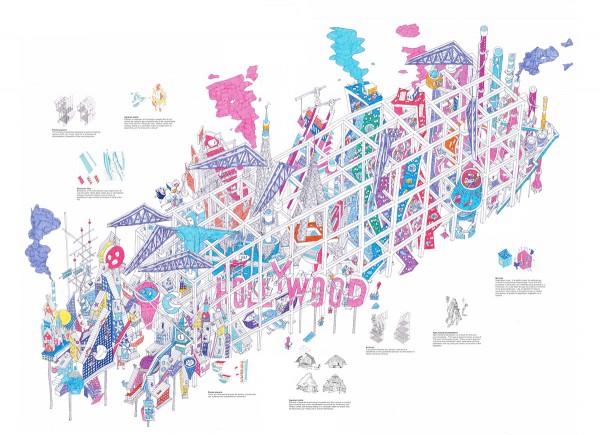 For the last few years mankind has accumulated more knowledge than in all its previous history. This factor enables us to say that in the next few decades there will be fundamental breakthroughs in science and engineering which will result in changing society and the architectural design of cities. The degree of its influence could be compared to the age of Great Geographical discoveries.
For the last few years mankind has accumulated more knowledge than in all its previous history. This factor enables us to say that in the next few decades there will be fundamental breakthroughs in science and engineering which will result in changing society and the architectural design of cities. The degree of its influence could be compared to the age of Great Geographical discoveries.Honorable Mention
Jethro Koi Lik Wai, Quah Zheng Wei Malaysia
Limestone hills that are mined are doomed to suffer total annihilation, or become remnance of a souless terrain. This design approach seeks to intervene the process of mining, turning it into a mere “site clearance and earthwork” phase to allow buildings to be erected within, adapting to the sophisticated and ever so beautiful terrain of the karsk topography. These towering natural monuments withstood the tests of time, until humans begin to mine their substances. Mining of these substances not only creates an eye sore, it also increases calamities such as flash floods and landslides. Therefore, it is vital that proper treatment has to be applied upon mining of the natural resources.
Limestone materials have numerous uses: mainly as building materials, as aggregate for the base of roads, as white pigment or filler in products such as toothpaste or paints, and as a chemical feedstock. This in turn, creates a building within a mountain, harnessing the natural resources of existing stones and minerals on site to be used as the construction materials eg. marble, travertine.
The Architecture serves as a compliment to the monolithic beauty in its original state, bringing a different life and purpose to the mining hill sites. Read the rest of this entry »
Honorable Mention
Qidan Chen China
Because of facing threat from alternation of the natural growth pattern, deterioration of the global environment and excessive harvesting of the living creatures, more and more species of animals and plants are now endangered on the Earth. How to maintain species diversity has become a crucial issue.
Endless reports of deforestation, city sandstorms, unpredictable death of elephants and brutal hunting of whales keep coming into the public eyes, while human beings are focusing on constructing their survival fortress and exploring potential habitat outer space. However, could we slow down the pace and ensure our future generations could have the same experience about this blue planet, and even the blue sky before industrial era?
Before rehabilitating successfully the livable environment and climate, or finding out artificial reproduction methods of all species, human have to build up a Noah’s ark, which guarantees the provision of three elements of life: sunlight, ] air and water. Meanwhile, enough soil and food are essential for growth and reproduction.
According to the IUCN Red List of Threatened Species, species are classified into nine groups: extinct, extinct in the wild, critically endangered, endangered, vulnerable, near threatened, least concern, data deficient, not evaluated.
Based on these basic concepts, scheme about Tower of Refuge has come out. Tower as a huge refuge, likes a self-operating machine serving all survival conditions. It can obtain and filter water and air, reallocate sunlight and transform solar energy for tower using. Read the rest of this entry »
Honorable Mention
Shi Yuqing, Hu Yifei, Zhang Juntong, Sheng Zifeng, He Yanan China
Nowadays, there is growing problem in global climate. Studies on atmosphere components provide possibilities for people to learn the law of climate changing. However, detected datum don’t include all the components of the atmosphere. We hope in this memorial building, it can get atmosphere samples automatically every year, and store the samples with reasonable system.
With time passing, the building will become a library to study atmosphere components changing with the most resources. In the meantime, future techniques will allow more thoroughly studying atmosphere, providing better ways to respond to climate change.
Background
1. Atmosphere components study
Since the industrial revolution, with more fuel use, more biomass burning, more motor vehicle exhaust, the concentration and distribution of both regional and global atmosphere have changed observably. And that leads to problems like global warming, ozone depletion, acid deposition, air quality going down and so on, which have much effect on earth environment and ecosystems, and put huge threat to human development. Therefore, the observation and study of atmosphere components is quite important. Carrying
on long-term steady observation of atmosphere components and its relevant qualities is essential for learning atmosphere components and its changing process. Such based studies on atmosphere components changing law, and responding to climate change and disasters, is one of the essential issues of achieving the unity of man and nature both nowadays and in the future.
2. Air samples are more important than datum
It’s not enough for studies on atmosphere components to only rely on clearly recording and studying datum. Earth atmosphere components are really complex, including solidities, fluids, and gas, with complicated physicochemical properties. There are limited datum from detecting existing air samples. And there is possibility that some unknown substances make much difference during climate changing process but could not be detected for now. Therefore, air samples are the most comprehensive data resources. Today’s
scientific researches often need early air samples. Nowadays these samples usually come from polar deposits. Although these samples are precious few and hard to define a particular year, they still help scientists study greenhouse gas concentration changes for the past 200 years. Modern advanced techniques also helped discover atmosphere component like hydro fluorocarbon, which were not paid attention to before.
3. Caution of scientific management should be called to the public
Human behaviors have large impacts on atmosphere components and global climate change. There were many serious air pollution events all around the world in history, such as Meuse River Valley smog event in Belgium in 1930, which has caused 63 deaths. And in 1952, the photochemical smog in London has cause 4000 people to death within four days. In recent decades, there is constant drought, flood, high temperature, rainstorm and sand storm happening, which is closely related to atmosphere components changes
due to human activities. In the 21st century, even if governments and scientific institutes have shown growing concern on environmental problems, without public consciousness of protecting the environment, it’s still not so optimistic of improving atmosphere pollution. There is reason that scientific approaches of improving the environment is too far away from everyday life. Thus, to show scientific work to the public in a better way, is essential to alarm them. Read the rest of this entry »
Honorable Mention
Luigi Bertazzoni, Paolo Giacomo Vasino Italy
Reversal Strategy is one answer to multiple emerging global questions. A single synchronic action can reverse the collapse of human habitat to a better scenario.
Simultaneous events seem to occour in the next decades. After the official statement of global warming (UN), the evidence of climate changes has dramatically actualized all the previsions about the increase of planet temperature. The question now is about the possibility to avoid the “non return date”. The politicians negotiation is all about emission reductions, but the only possible strategy nowadays is to reverse the trend of global greenhouse effect.
Meanwhile time is giving to human civilization another deadline: the decomposing process of Carbonation makes reinforced concrete structure unstable in 70/80 years. Almost 60% of global concrete structure buildings was built in the 20 years after WW2. This means that in the next decades an impressive number of heavy and expensive structural refurbishments or reconstructions must occour. The collapsing risk of most concrete cities is increasing year by year. It is necessary to think new durable construction systems to reverse the collapsing trend and to substitute existing exhausted buildings. It is important to find a “new construction land” to build before moving people and functions. Then is possible to demolish what substituted. Urban areas figures demonstrate an increasing expansion of soil sealing and land consuming despite agricolture and wood. Private closed spaces are way much more determinating the urban grow while percentage of pubblic open spaces is decreasing. The consequence of this tendence on environment and landscape is known. Planet earth deserve a reversal strategy to change proportion between “closed land” and “open land”.
Reversing figure ground
How to “substitute” a massive amount of buildings with new ones without urbanizing open land? A possible answer is to build on the top of urban mobility network. Narrow structures can rise on the side of roads, just on the edge of urban blocks. These structural walls will became “the new construction land” leaving vehicles circulating at ground floor. Then infinite combinations of shells units can be hanged to the main structure. At this point local inhabitants can move to their new accommodation facilities, leaving old ones free to be safely demolished on places. Ruins will rise up ground floor level while roads and parking will became underground. Former blocks areas freed of constructions, will create a continuous sequence of pubblic open spaces, parks, squares, or even cultivated land, exclusively for pedestrian. Cities figure ground diagram is now completely reverted: old blocks are public open space, old streets are covered with buildings.
Reversing global warming
A photo-catalyst based on copper oxide or other molecular catalyzer, will make possible, in a few years, the production of an Artificial Photosynthesis Leaf. The process, already prototyped, uses solar light, CO2, H2O to produce Hydrogen, Carbon, and Oxygen. This would not only remove carbon dioxide from the environment, but also turn it into solid carbonates that could be used for building construction. At the same time water splitting process will produce Hydrogen for all energy needs through Fuel Cells
technology.
Reversing collapse of concrete cities
Research on Carbon composite materials suggest that in a few years will be available a strong and light “Carbon Concrete” able to last for thousand years. It will be possible to build very tall and thin structures to represent a new “vertical land”, good for living/working facilities. A perforated double layered structural walls made of Carbon-fiber-reinforced polymer or Carbone Concrete composite material, will be the base to hang a flexible combination of living shells, vertical transportations, and plants
to realize a multi-level city. Read the rest of this entry »
Honorable Mention
Stuart Beattie United Kingdom
In the past few decades the world economy has seen a global shift of industry and manufacturing eastwards to the emerging markets of China and India purely for economic efficiency but not innovation. The rate at which urban populations are expanding will impact upon how we perceive the strategies of sustaining our cities with regards to supply and demand. The rise of global cargo shipping has seen the ability of local industries to move their production to areas of low labour, tax and land costs.
However, the onset of rising labour costs in East Asia, higher transportation costs, a weaker dollar, rising U.S. productivity and cheaper energy are only enhancing the argument for more localised production that is closer to the consumer.
The population of New York City is forecast to grow by 12% to 9.4 million people in the next two decades resulting in a current city-wide acute affordable housing shortage. Manufacturing land in the city is perceived by planners as a viable outlet for the expansion of residential development, forcing a gradual decentralisation and extinction of local industries which are inherent to a wider network of urban ecologies within New York.
In addition to a declining manufacturing sector, not aided by recent re-zonings or passive policy measures, the pressure on manufacturers to relocate in the face of development-led socio-spatial conflicts will only grow exponentially with a burgeoning population and an ever increasing reliance on imports. Economically diverse cities such as New York, with a substantial inventory of old, functionally unsuitable factory structures have the capacity to look at the new innovative and flexible industrial methods to revive manufacturing locally and regionally. However, the assumption that the city’s manufacturers are a dying breed or an anachronism epitomises the enormous challenge that the sector faces.
This project investigates the possibility of an alternative to inefficient horizontal industrial sprawl by considering the prospect of a new vertiginous architectural typology in the form of a vertical factory devoted to the stabilisation and re-integration of manufacturing into inner city Brooklyn. These interventions aim to act as a compromise to residential development aspirations and the shortage of suitable industrial land. The new typological approach speculates the re-establishment of the once prominent manufacturing economy in the face of malign policy neglect and the City’s focus to sustain New York’s economy primarily through finance, insurance and real-estate initiatives.
Arrayed along the Greenpoint coastline and orientated to the formalised Cartesian street grid, the agglomeration of 21 towers are manifested as an archipelago of site-specific interventions which are encompassed by an essential infrastructural network of highways, trainlines and ports that aids the stability of the industrial ecology. Acting as a spatial clustering of industry, the proposal aims to incubate and augment current inter-urban relationships emphasising the importance of local knowledge on steady growth and innovation.
Each tower can accomodate from 52 – 81 small industries providing a maximum of 103,950 sqft of manufacturing space and potentially more than 1000 jobs. Maximum spatial allowance and flexibility within the factory nodes are achieved through an exoskeletal structural system and column free floorplates served by exterior lift cores that provide lateral stability to the overall tower. The floorplate dimensions of the proposal are not designated towards any particular industry but serve to provide a series of intimate, generic industrial spatial volumes which local 21st century manufacturers can occupy. Although as an ideological interpretation, the scheme is intended to provoke discussion as to an alternate approach to retain the local manufacturing sector and how these small industries can be encouraged in the face of alternative urban, political and neoliberal economic imperatives. Read the rest of this entry »
Honorable Mention
Ma Yidong, Zhu Zhonghui, Qin Zhengyu, Jiang Zhe China
With the increasing demand of energy resources and the exhaustion of inland petroleum, the exploitation of marine seems inevitable. The drastic development of offshore rigs, however, comes with the great potential risk of oil spill, which will endanger the whole marine ecosystem tremendously for decades. The clean up of the spill, however, is still inefficient and time-consuming.
Our design transforms the original rigs into vertical bio-habitats, which aims to exert instant response to oil spill, restore damaged eco-system and offer all beings shelter from future disasters. The original rig will become a reactor center, where the spilled oil will be converted into catalyst and building materials, as well as a recreational center and research facility. The structure underwater will be attached to pipes with a floater at the end. Our strategy could be divided into the following three periods of time.
1. Short term strategy: absorption of spilled oil
When an oil spill incident happens, the floaters at the end of each pipe will immediately absorb the spilled oil covering the surface of the sea as an instant response.
2. Medium term strategy: Habitat for marine life and migrating birds
The collected oil will be transported through the root-like pipes underwater to the central processor attached to the original rig, where the crude oil will be converted into catalyst for coral reef and produce plastic as building material. The catalyst will be transported back to the pipe to booster the growth of coral reef on its surface and the plastic will become the building material of the plastic-twig structure with the help of 3d printing and the injector. In this way, the project will become a habitat for vertical bio-habitat and help revive the biodiversity.
3. Long term strategy: shelter from future disasters
Ultimately, when the sea level rises to a disastrous degree, the twig like structure would continue to remain above the sea level. Then the oil rig will become the Noah Oasis. Read the rest of this entry »
Re-Generator Skyscraper: Plan to Regenerate the Wetlands of Hangshou
Honorable Mention
Gabriel Munoz Moreno United States
The constant change and growth of the human population that we are experiencing these days produce a collateral damage in the natural ecosystems where the cities stand all around the world. This damage is produced by today´s building and urban systems that do not take into account the natural environment where they are built.
The expected and rapid population growth for the first half of the 21st century, propelled specially by the developing countries, results in a need to research about alternatives to today´s building methods in order to provide construction tools and guides that makes urban growth compatible with the preservation of our environment. Moreover, I believe in the power of architecture to change the future of our cities and generations, and with that, our thinking and behavior towards an understanding between the places that we inhabit and our ways of living in them.
The project stems from the analysis of the population growth of Hangzhou, China. The direct consequence observed was the partial destruction of the ecosystem on which the city stands, the wetlands. The construction system used so far does not support them. In China and all around the world, the population will continue growing, and the continued use of the current construction system, will end up destroying their ecosystems entirely.
As a solution to this, I propose a new construction system that is organized, distributed and expands as cells throughout the city. This cell is elevated above the ground, to make way for the recovery of the wetlands. To do so, it should be translucent and permeable, without disrupting the natural cycles of the sun, air and water, which allows the natural regeneration of any ecosystem.
Furthermore, the cell is supplied with different “inputs” to make possible the habitability and the cleaning of the wetlands, using its waste to encourage self-sufficiency. These mimic different parts of natural cells and enables our construction cell to be a living element, a system in constant change and growth, regenerating the ecosystems, in this case the wetlands of Hangzhou. Read the rest of this entry »
Honorable Mention
Yongsu Choung, Ge Zhang, Chuanjingwei Wang South Korea, China
The skyscraper is one of the type of architecture which is still under the strong influence of Modern architecture. Generally, a skyscraper is limited to flat floors for efficiency of construction and glass façades for placing premium on expansive vistas of the city below. Therefore, skyscrapers have not changed very much since their introduction unlike other types of architecture, since the height and the transparency of skyscrapers are the absolute standards to determine their values in this era.
This project avoids the typical skyscraper and aims to create a new typology. Instead of approaching the design with an existing architectural methodology, the design is approached from the skin. To be precise, the research focused on, not on a skin of an existing architecture but, a skin of living organism, a shark skin, in order to adopt its system for a façade design. The analysis of the configuration of a shark skin, especially how it is formed in macro and micro scales has led to the idea of ‘Deep Skins’ in which, different inner volumes of the tower is derived from various skin types. The idea of Deep Skins has a potential of being developed to the scale of a tower.
The proposed building is located on 157 West 57th street in Manhattan, New York City, between the 6th and the 7th avenues. The layout of programs follows that of a typical tower in New York City. However, the tower is composed of accumulated volumes transformed from a prototype, instead of flat floors, according to the programs. The resulting design stands as a towering interlocks of tightly packed units that are varied beyond the norm and yet provides a desirable level of privacy and intimacy simultaneously. The sense of intimacy from the interlocking and from the billowing interiority introduces a new sense of community for a type of structure that is bound to be highly liquid and mobile in terms of occupancy throughout its existence.
In that sense, the idea of Deep Skins is about intimacy as much as it is about vistas, or precisely, about how to approach the vistas that are invaluable. Like in a conventional skyscraper, the inhabitants and pied-à-terre investors would admire the vistas, but instead of simply panning across a homogeneous panorama from floor to floor, they are looking out from round apertures that cantilever out midair, urging one step out further, with more embrace towards the physicality of the tower itself.
While highly energetic when seen from the west 58th street towards the base and the streets, calm moments are found towards the top and the facades facing its adjacent neighbors.
As shown in sections, such consistent attitude of viewing is attended towards vistas created in the core of the tower itself where vertical volumes of great heights can be found and in the large opening a midway up the tower that functions as an outdoor sky lobby. While manifold like floor plates and billowing walls vary individual experiences, the attitude of approaching vistas unites the tower looking out and looking in as it does vertically.
New York City is experiencing a new golden era of high-rise constructions, with skyscrapers booming all over Manhattan in recent years and a 300 meter tall tower is currently under construction on the site. The idea of this tower is a counterpoint to the much ingrained transparent and spectacular qualities of glass towers that are perpetuated throughout the modern skyscraper architecture. Read the rest of this entry »
Honorable Mention
Ramiro Chiriotti Alvarez Spain
Why we still design cities by dividing the ground in urban plots and defining heights for each building? Why don’t we think our cities as a whole, planning them from the three dimensions at the same time, allowing us to define positions freely for our constructions in the space (x,y,z axes).
Let’s think and create new cities in a three dimensional development system that won’t consider the ground as the main one, and will permit to have several of them “floating” on air. That would allow the creation of new green areas on the rooftops, creating new forms of living, working, circulation… and public space relationships.
Thinking about cities through a three dimensional point of view could be a good way of hyper-densifying cities even when they are extremely dense without affecting negatively the existing living conditions. This is the case I examine, taking as an example of a very dense urban fabric: in the Haizu district in the city of Guangzhou, China.
In many Asian cities, urban development has come about extremely quickly in the last decades, promoting overly dense areas with very low living standards, making life significantly harder for inhabitants.
These zones reflect the culture and history of the country and demonstrate the growing trends in Asia to live in close proximity with small spaces. However these situations are sometimes negative in many aspects and ask for solutions, local way of living cannot be changed overnight doing a complete “tabula rasa”. That’s why considering examples that took the general 2D planning method, with a complete anarchy resulted into “incredible” monsters like the Kowloon city. Thinking the cities as a whole won’t let that happen but will permit a very dense fabric with good quality of air conditions, light, green space access, mobility…
The “Hyper building” hasn’t come out from subjective interests or aesthetics preferences. The project is a direct use and re-interpretation of the existing urban fabric geometry. While it responds to a certain subjective approach, the main concept that shapes the “Hyper building” is that the final form appeared from a parametric composition made by the superposition of existing site layers, extracted from the footprints of the urban fabric connecting them in such a way that every floor is different from the others.
In order to maintain and build new housing and activities structures the project imagines a development where the inhabitants of the existing site will be involved in the decisions of the future city; which buildings will stay, which will be taken down, and how the city performs on a larger scale. The result of that proces would be a mutable and adaptable tower cluster that emerges from the existing conditions to establish a spatial net of buildings and green spaces.
The Hyper building is conceived from the idea of being almost an independent city, with its typology will allow different use distributions, creating and keeping all kind of activities together (commercial spaces, production, offices, schools, health centers, small farming spaces, warehouses…) to maximize the quality of living of its inhabitants.
The overall guiding concept is that the “Hyper building” emerges from the existing fabric like the roots of a tree emerge from the ground. This building develops different density conditions and through this process, the building cluster expand horizontally and begins to increase in height, transforming into a tower.
This 3D participation planning system could be adapted to the urban fabric of the neighboring areas, as well as in many other Chinese cities, which all have similar conditions and seem to be overlooked as potential interesting sites for new urban poles. Read the rest of this entry »
Honorable Mention
Blake Freitas, Grace Chen, Alexi Kararavokiris United States
As our planet continues to overpopulate, Times Squared 3015 is an opportunity to explore the spatial, environmental, and experimental possibilities of vertical living. This tower embraces the problems of overpopulation, farm production, oxygen generation, and the re-purposing of obsolete infrastructure.
The tower grounds itself in the heart of the city that never sleeps: Times Square, New York City. The existing framework of Times Square take on a different, three-dimensional form, as the tower rises above it, driving the concept of Manhattanization to new heights. Peaking over a mile above the city, the tower pushes the boundaries of how vertical a skyscraper can be. When fully taken advantage of, Times Squared 3015 proves the skyscraper typology capable of fitting an entire city within itself.
Vertical farming, beach, mountain range, stadium, redwood forest, housing, and offices–destinations that are normally farther apart, are now stacked vertically. Each one of these destination zones consists of an individualized block or module, much like ¬ the different districts in a horizontal city. Open space is carved out of the south-facing side of the module for maximum solar exposure, regulating the destination environments within. This creates a series of L-shaped ‘living’ clusters — the city fab¬ric — that surround and integrate with the natural environment.
Located above and below the residential/destination modules are a series of retail-themed entertainment modules or ‘sky malls’ that draw upon the vitality of Times Square and extend the same excitement and energy vertically throughout the tower. Finally, using the idea of the skyscraper as makeshift observation deck, an enclosed city in the sky resides at the very top of the tower, providing dizzying views of the city within a city.
Circulation is handled by the main core, a massive elevator system/vertical subway that minimizes travel time by only stopping at the twelve major modules that make up the tower. From there, travelers need only use a series of secondary elevators / stairs to journey vertically within each module.
This vertical organization introduces a new kind of daily life. Farmers tend to vertical farms that take advantage of southern exposure and provide oxygen and sustenance to the tower’s community. Residents have a beach or a redwood forest right in their own backyard. A shopping mall or the latest football game are just an elevator ride away. All of these factors combine to create a lively and dynamic self-sustaining city experience for a rapidly growing future population. Read the rest of this entry »
Honorable Mention
Nikolay Zaytsev, Elizaveta Lopatina Russia
This project is based on a complete transformation of an Arctic hub port. It is necessary to create comfortable working and living environment of the Northern Sea Route transport infrastructure. The initial idea is to design a separate anthropogenic microcosm, detached from the harsh Arctic environment, but based on the dynamic equilibrium between people and nature. The structure of the proposed building is same to the structure of nature, the earth’s crust, the structure of usual human perception.
Symbolically imaginative solution consists of two main parts: a square of a “man-made” land and circles of supporting heaven pillars. The result of designing is a single “horizontal skyscraper” high-rise building bearing all the functions of a port city, with a possibility of expending.
The aim of the project is to increase population of Dikson city from 674 to 5,000 through attracting people with various skills from all over Russian Federation. The proposed building is a multifunctional complex that can replace the existing ruined port city. Two distinct types of housing are created – housing for permanent workers with families and housing for temporary workers. Residential and public areas are augmented with large green recreational areas. For this purpose the project employs natural and artificial lighting, since the Polar Night lasts three and a half months in this region.
One of high priority tasks of this project is to redefine the energy supply of the city and the region on the whole. It requires switching from scarce fossil fuels to more environmentally friendly energy sources. In Dikson the most available and abundant energy sources are wind and tidal power. The output capacity of designed wind and tidal power plants could reach 500 MW, which is enough to power a city double the size of St. Petersburg.
Water supply is another important aspect to reach sustainable development. Because of the small amount of fresh water available the project involves the use of desalination plants and rainwater harvesting. Green zones’ irrigation systems use water coming from the water recycling system.
The proposed building is deliberately separated from the harsh environment, and at the same time is transparent and light-weight. The internal building’s space is visually exposed to Kara Sea, Dikson Island and the mainland.
This project is expected to renovate region’s development, attracting both government and private investors, and to become a key point in global transport infrastructure. In this case the project would be a start of the comprehensive Arctic exploration. Read the rest of this entry »
Honorable Mention
David Sepulveda, Wagdy Moussa, Ishaan Kumar, Wesley Townsend, Colin Joyce, Arianna Armelli, Salvador Juarez United States
Seen from space, the majority of the Earth’s surface is covered by oceans – that makes up 71% of the surface of the Earth, with the remaining 29% for land. But what percentage of the Earth’s land surface is desert? Deserts actually make up 33%, or 1/3rd of the land’s surface area. Desertification is yet another consequence of climate change that takes a great toll on biodiversity, natural resources and, ultimately, the lives of people who inhabit drylands. Along with measures to curb and compensate it, there are several solutions for bringing life back to arid lands. It is called “reversing desertification”, and it has a great deal to do with permaculture. Permaculture is the development of agricultural ecosystems intended to be sustainable and self-sufficient.
“You can solve all the world’s problems in a garden.” – Geoff Lawton
The largest non-polar desert in the world is the Sahara Desert, a subtropical desert in northern Africa; it covers a surface area of about 3.5 million square miles. Just to put that into perspective it is as big as the United States of America, only difference is that desertification and land degradation increases about 12 million hectares each year, the size of New York State!
Ironically, where the Sahara Desert ends is where agriculture started, Ancient Egypt – Cairo. The civilization of ancient Egypt was indebted to the Nile River and its dependable seasonal flooding. The river’s predictability and the fertile soil allow the Egyptians to build an empire on the basis of great agricultural wealth. Egyptians are credited as being one of the first groups of people to practice agriculture on a large scale.
This in return created such monumental cities like Giza that features the Great Sphinx and Pyramid constructed around 2584 BC, which is the resting place of the Egyptian Pharaoh Khufu. This is the largest of the three pyramids that make up the Giza Necropolis, along with the pyramids of Khafre and Menkaure. All these facts lead to the same re-occurring issues that we deal with in today’s progress to evolve not only technologically, but socially as a human race. We put too much emphasis on materiality, consumption and tourism and not enough back to the point of origin from the inside out.
Concept
Our project “Bio-Pyramid” proposes that we throw away the status-norm on historic preservation/ tourism and create a super-hybrid of re-activating areas that truly make a global difference. “Bio-Pyramid” is a non-conventional skyscraper that not only operates as a “bio-sphere” but also as a gateway from Cairo across the Sahara Desert; linking a sustainable armature to reverse desertification from a monumental to small nomadic scale. This proposal is not only a viable economical gain for cities like Giza and Cairo, but also stands as an architectural eco-techno statement that mixed-use typologies are more relevant as we diverse globally and sustainably. With over population and consumption on the rise we need to find a way to merge different typologies
“The past, like the future, is indefinite and exists only as a spectrum of possibilities.” – Stephen Hawking
Geometric Evolution
Geometry has always been a critical driving force since ancient times to now. We can trace different architectural movements from function follows form or form follows function, to the abstract randomness of today’s technological capabilities. We can also justify certain typological skyscrapers being certain uses and shapes through climate, finance, art, politics, tourism, etc., but we rarely explore the capabilities of morphing several disciplines into one. Bio-pyramid does just that, it is an evolutionary morphisms of the ancient pyramids + modern skyscraper + bio-sphere.
The second layer to this complex hybrid is that it serves a second agenda, in that we do not only consider this a historic preservation project, but also strives to de-centralize tourism and actually function as a “living machine” back to its local communities. Bio-pyramid investigates the relationships between architecture, urbanism, landscape, historic preservation and technology with an emphasis on using environmental performance as a generator for architectural form. Read the rest of this entry »
Honorable Mention
KHZNH Studio: Amir Izzat Adnan, Nur Farhanah Saffie Malaysia
City populations are growing faster than the city infrastructure can adapt. The world’s cities are growing because of population shift especially concerning rural to city areas in search of jobs and other opportunities in hopes for improvement of lives and creating better future for the younger generations. Along with the growth and expansion of cities, comes the rise in environmental issues and problems. It comes to the role of future architects, planners and developers to achieve green and sustainable strategies where modern buildings can rely on new forms of energy.
Although most skyscrapers provide solutions of catering the density of population with the spaces they provided as compared to the available space on land, it is highly argued that they do not provide good street-level experience that hence, totally disconnect the street cultures from vertical structures. This disconnection has led to the difficulties, in a case of high-rise apartment living, for families to experience the community living where the proximity to other facilities available in street culture is higher instead of being constrained in the walls and perimeter of the vertical structures they live in.
The exploration of horizontal skyscraper aims to offer dwellers a maximum recreational experience almost as much as living on the ground or surface of the streets. This horizontal skyscraper is building a community where neighborhood qualities and everyday life practices are carried through. People relate to these living environments as part of their identity and, thus, neighborhood community living becomes personally meaningful and relevant. In fact, studies have shown that people who live in close-knit communities
are statistically safer and less likely to be burglarized.
By honoring the culture of the nature setting, the Vernacular Sky-Terrace invites visionary ideas for Kampung Baru to become a better city without ‘touching’ the existing fabric. The basic idea for this project is to elevate the existing site and improvise! The decision of hovering over the existing site is inspired by the aims to create one community consisting of office spaces, apartments, commercial area and public landscape also to generate the largest possible green space open to the public, right in the heart of Kuala Lumpur city. Read the rest of this entry »
Honorable Mention
Zhang Zehua, Song Qiang, Liu Yameng China
So forgettable, so engraved. Time dating back to April 26, 1986 ,a quiet night. With a big bang , the fourth reactor of the Chernobyl nuclear power plant exploded, the amount of radiation is about 400 times of the atomic bomb which was dropped on Hiroshima. About seven million people were forced to leave their homeland in two days, they had no time to say goodbye to their present life.
But not everyone accepts the arrangement of fate. The negative effects of radiation have been dafeated by a large group of settlers, more and more people are returning to their homeland which located in the restricted area, what can be sure is that they use a different way to look at the risk which they bear . They survived from the harshest environments in the 20th century, Stalin caused the Great Famine in Ukraine in 1930s,which caused millions of people to death, they also experienced the atrocities of the Nazis in 1940s. Therefore, after the Soviet government is stable for years, the Chernobyl incident happen, they do not want to leave because of the enemy which is invisible . There is a kind of heroic toughness and frank reality in their character.
For the people who return , home is no longer a transitory concept , it is a force even to resist the radiation. Their spirit will let us review the meaning of the relative risk and grab a kind of internal emotional contact of motherland— Fallen leaves return to the roots.
This project aims to build a skyscraper for them, the air purification equipment and water purification equipment are contained in the skyscraper, the solar power is used to provide energy for internal devices. the skyscraper is just like a Garden of Eden, a new and safe life will start from here. Read the rest of this entry »
Honorable Mention
Taehan Kim, Seoung Ji Lee, Yujin Ha Republic of Korea
Neither did we know at first that the juvenile yet ingenious imagination of touching and catching the cloud would bring balance to the Earth…
The mankind, despite their remarkable advancements, could not for once surpass the greatness of nature. In the face of devastating floods and droughts, our bests were mere building of dams and planting of trees. But one day, the abnormalities of climate started to exhibit signs of balance.
The balance comes from redistribution of cloud. Capturing then releasing the clouds from where they are affluent to scarce started to change the color of the planet Earth. The arid-yellow deserts transformed themselves as fresh green. Changes in the nature were only the start of all the other transformations to follow. Read the rest of this entry »
BIBLIOGRAFIA/FONTES:
Agradecimentos aos Editores da eVolo, pelas permissões e fornecimento do material deste concurso.
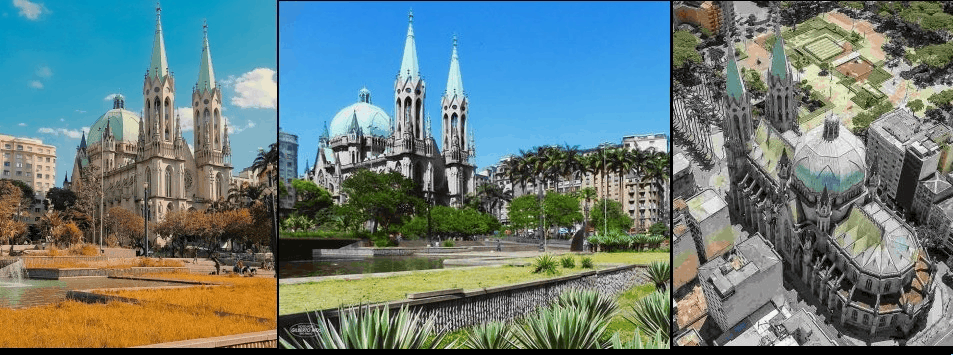
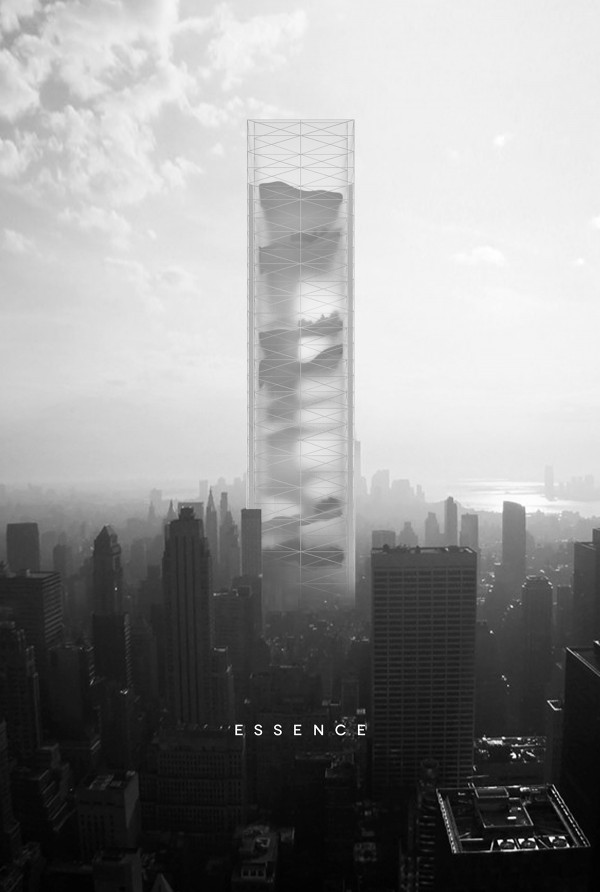
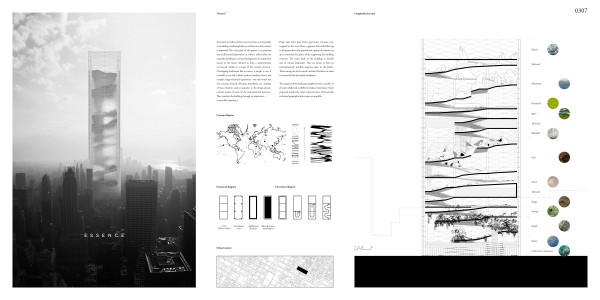
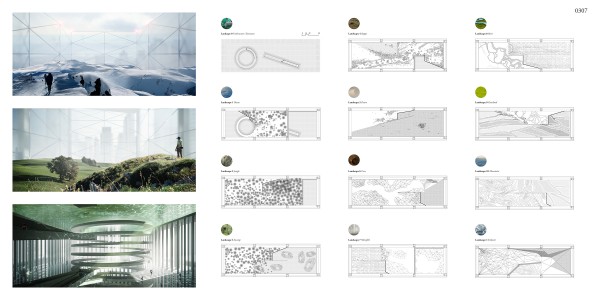

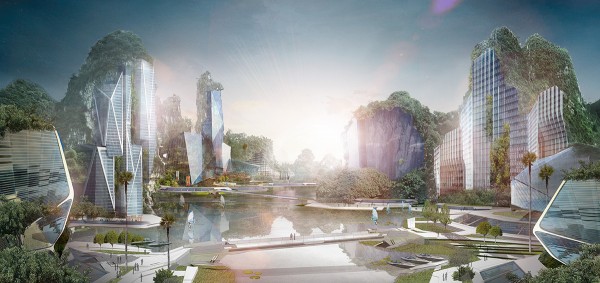
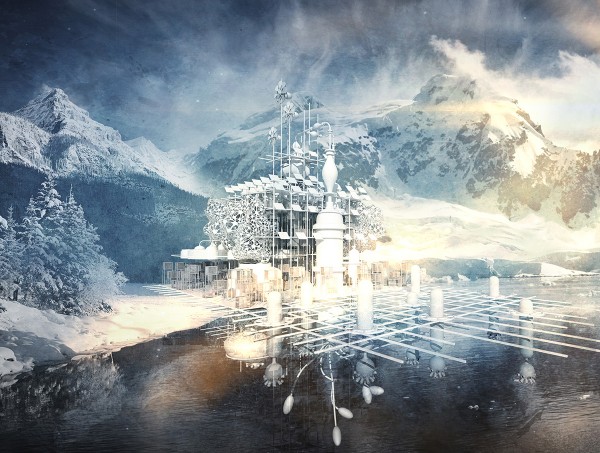
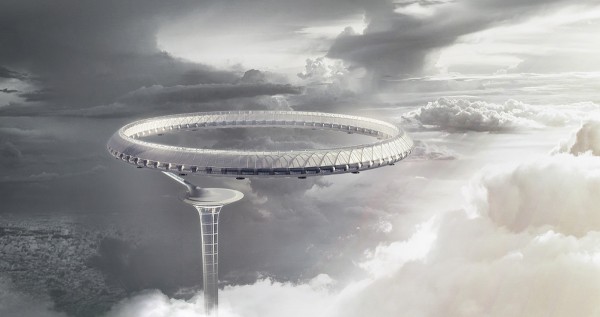
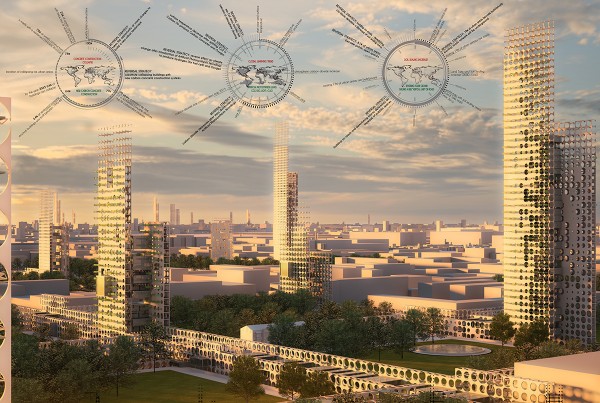
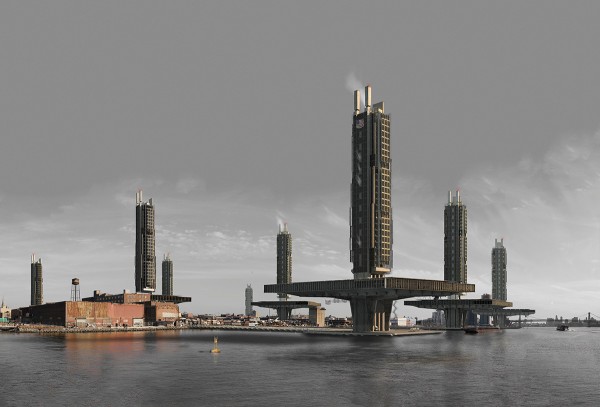
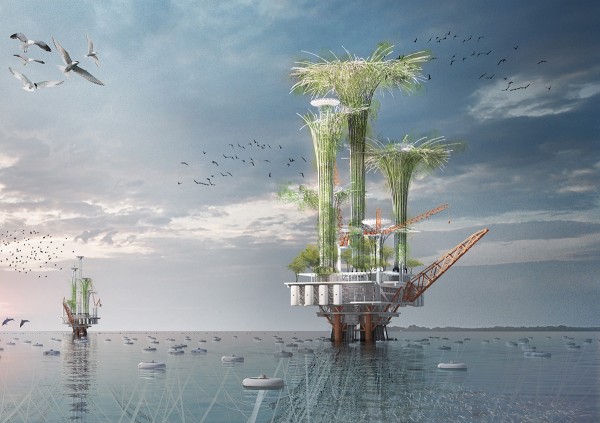
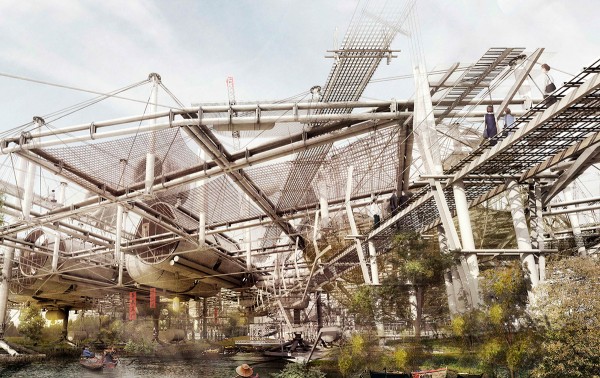
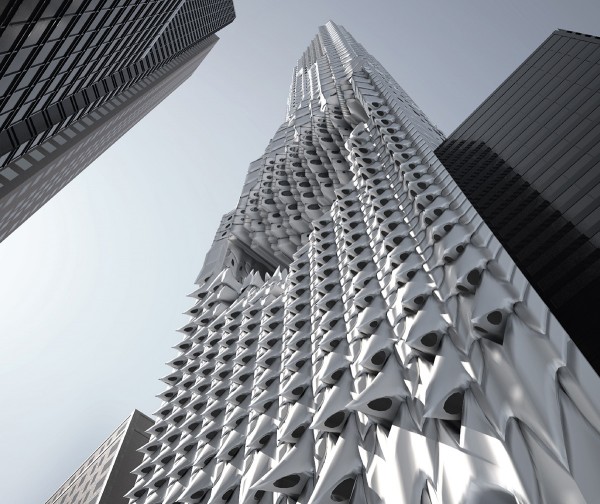

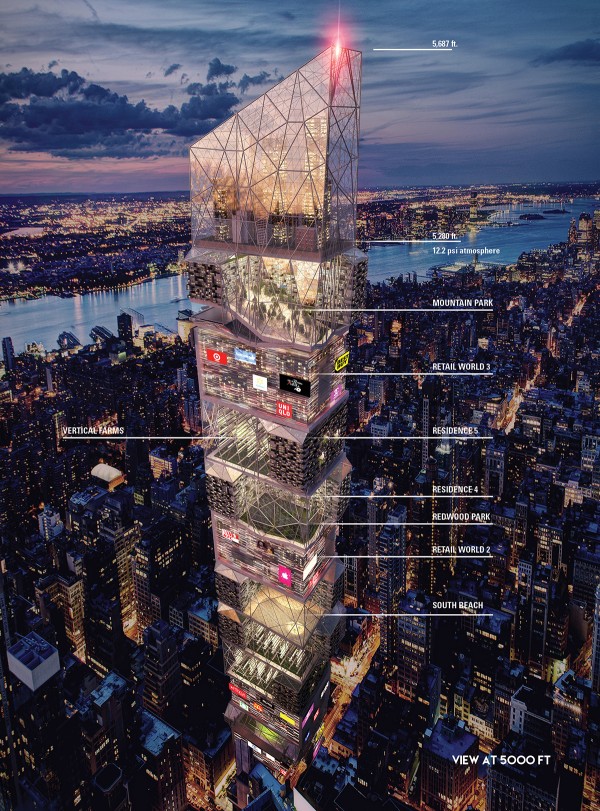
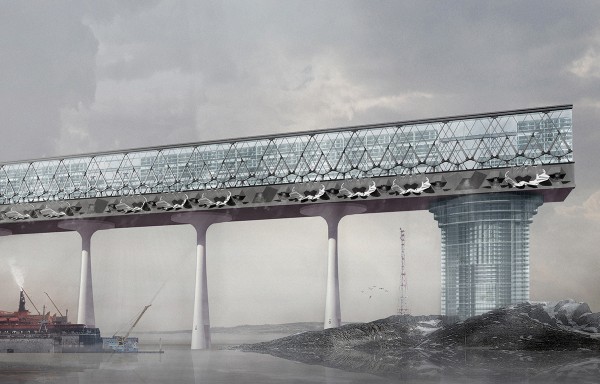
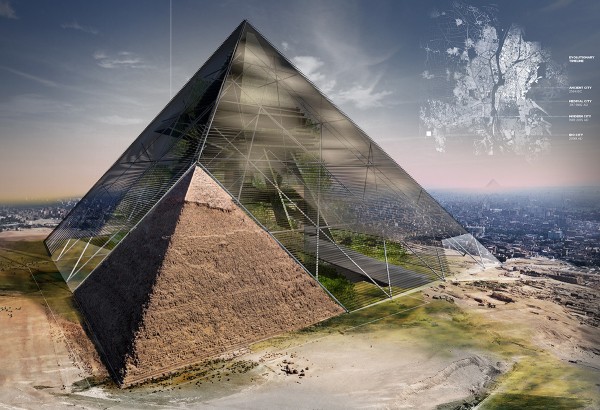
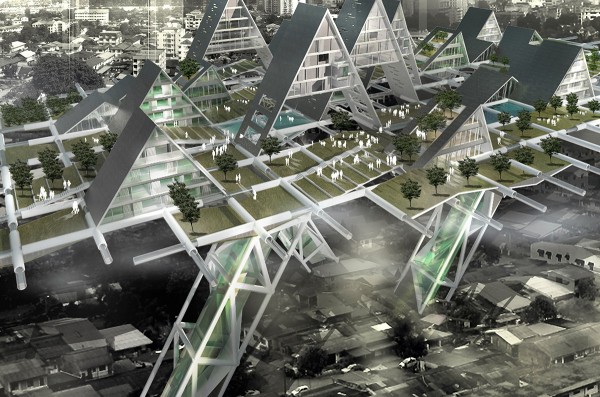
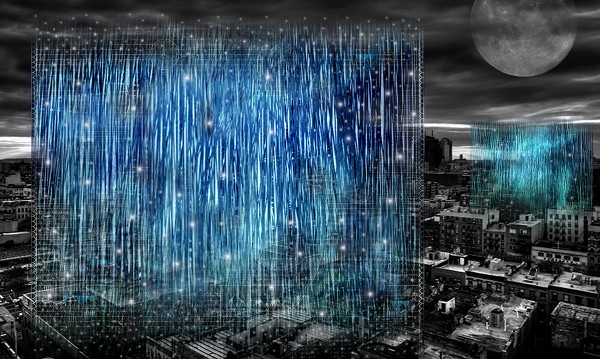


Lindos projetos, perfeitos! Até curti as de 2014, aliás, foi mais proveitoso, pois estava numa linguagem, digamos, “mais amigável”!